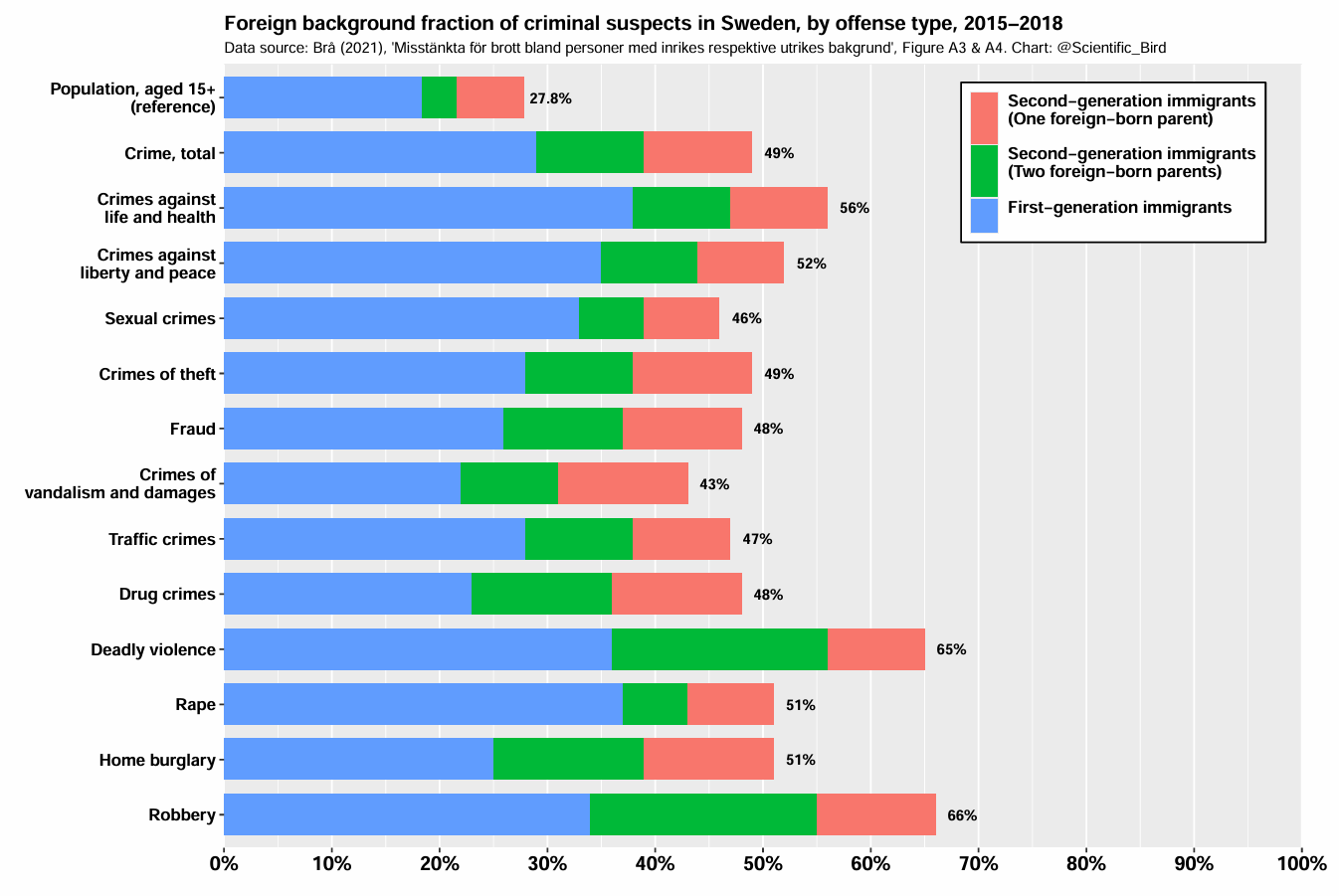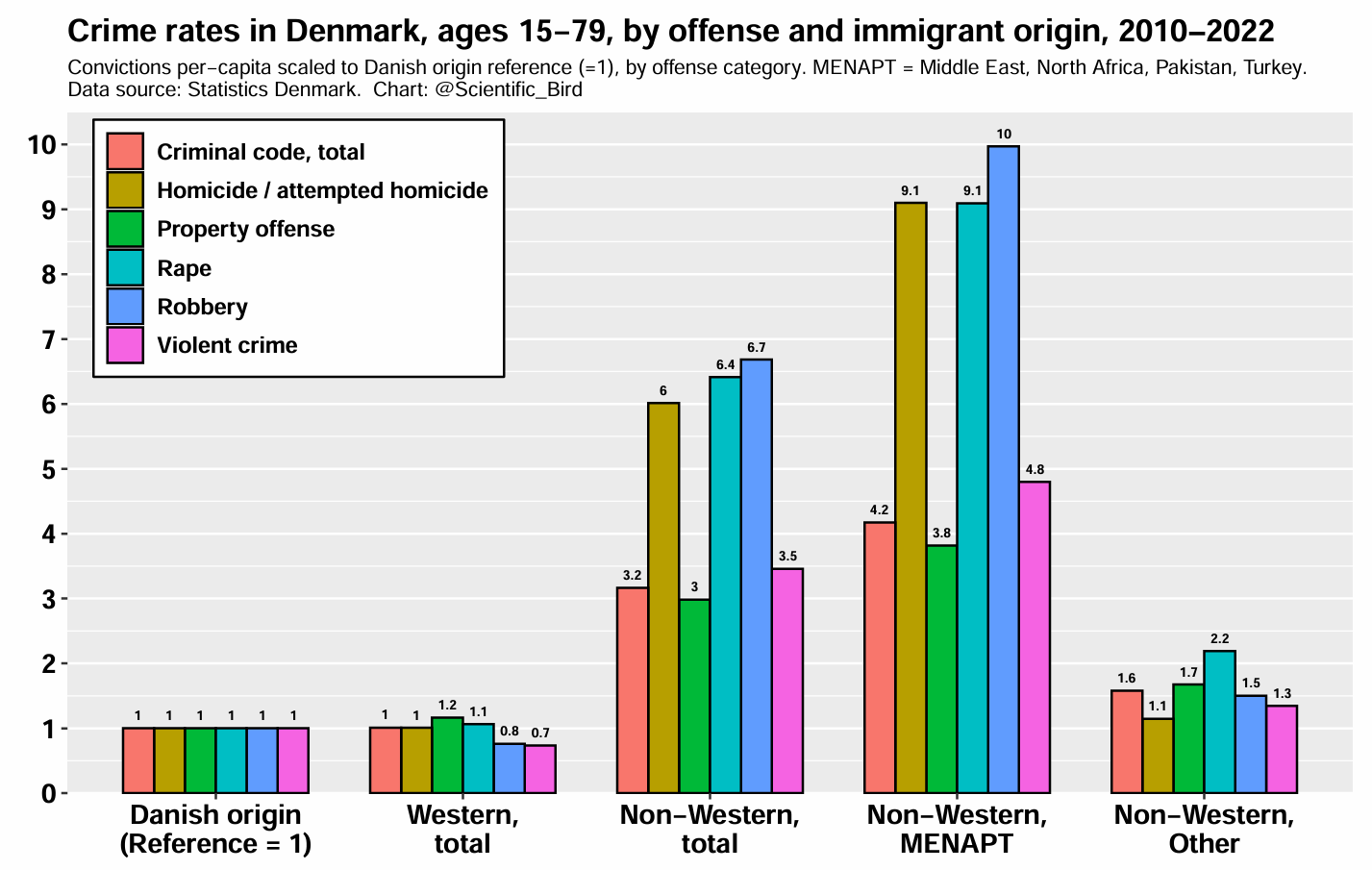Immigration and crime in the Nordics
A collection, description and visualization of data from the Nordic countries
This is part of a series. See also:
Introduction
A major source of contemporary Western political debate are questions related to immigration and crime. This post consolidates data from the four major Nordic countries: Denmark, Finland, Norway and Sweden.1 I will first provide a brief review of evidence and sources of data from each country, and afterwards go into greater detail.
Beyond the basic question of whether immigrants are overrepresented in crime or not, I will address several related points:
Immigrant heterogeneity. How do crime rates vary between different immigrant groups?
Etiology. Which factors explain (or don’t explain) criminal disparities?
Immigrant persistence/assimilation. Do criminal disparities persist to the next generation, or do groups assimilate?
Specific types of crime. Additional data regarding specific types of crime.
Brief literature summary
There is no doubt that people with foreign background are overrepresented in crime in the four Nordic countries. I will briefly summarize some of the data that establishes this conclusion, but first I need to address terminology used throughout this article.
Definitions
In line with typical convention in Nordic statistics, “immigrants” refer to people born outside the country in question (i.e., first-generation immigrants). “Descendants” refer to those born inside the country, but have two immigrant parents (roughly speaking, second-generation immigrants). People with “foreign background” are those who are either immigrants or descendants. “Native background” is simply the absence of foreign background.
Sweden
In a review of Swedish data, criminologist Amber Beckley (2015) writes: “Studies unequivocally show that people with a foreign background have about double the rate of crime compared to people with a Swedish background … The crime rate disparity persists after standardizing for socioeconomic factors.”
This overrepresentation is observed regardless if suspect data or conviction data is used (Brå, 2021; Bäckman et al., 2021). Studies show that individuals with foreign background are overrepresented in offenses of violent crime, deadly violence, and rape (Frisell et al., 2011, Khoshnood et al., 2020; Khoshnood et al., 2025).
Denmark
Unlike in Sweden, annual reports are issued by the Danish government and published by Statistics Denmark. They consistently find that people with foreign background are overrepresented in crime. Individuals with foreign background are also overrepresented in prisons (Kriminalforsorgen, 2024).
After adjusting for sex and age, non-Western immigrants and (especially) descendants are overrepresented in crime (DST, 2024, p. 115). According to the same report, this remains true if income is also adjusted for (table 6.7).
Norway
Over the years, there have been several studies about immigration and crime in Norway using register data, most of which are reviewed by Skardhamar (2017). These studies confirm that individuals with foreign background are overrepresented in criminality in Norway.
Notable examples include Andersen et al. (2017); Skardhamar et al. (2014); Skardhamar et al. (2011); Evensen (2009); and Kardell & Carlsson (2009). More recently, Statistics Norway (SSB) have published relevant data in 2020 and 2024, though without any associated detailed reports or statistical analyses.
Finland
Statistics Finland directly provide crime rates by national origin which can be publicly accessed by query. These statistical tables show that many nationalities are overrepresented in crime (see, e.g., StatFin, Table 13jg). Several detailed reports and articles confirm this (Danielsson et al., 2020; Kotiniemi, 2015; Lehti et al., 2014; Skardhamar et al., 2014).
With this brief overview established, I will now analyze and visualize Nordic data in greater detail. I will consider how crime rates vary between immigrant groups and by offense type; whether differences in age, sex and socioeconomic factors can explain criminal disparities; and to what extent criminal disparities lessen with assimilation; and more.
Immigrant heterogeneity
Crime rates differ markedly between immigrant groups—to such an extent that Skardhamar et al. (2014) conclude that “it is questionable whether one should treat immigrants as one single group at all.” I concur.
When approaching this topic, the better framework is to view it as part of a broader analysis of group disparities in crime. Whether immigrants are overrepresented in crime depends crucially on the group in question (or the composition of groups), and on the people they’re being compared to.
While people with foreign background are overrepresented in crime in the Nordic countries, when looked upon with finer granularity, this evidently doesn’t apply to all groups. In the Nordic countries, the foreign criminal overrepresentation is driven mainly by higher crime rates among non-Western immigrants and descendants—in particular those who descend from MENAPT (Middle East, North Africa, Pakistan and Turkey) and Sub-Saharan African countries.
Using conviction data provided by Statistics Denmark, I have illustrated this below.
The differences are large. Crime rates of Western immigrants and descendants are similar to those of people of Danish origin, and even slightly lower for violent crimes. Non-Western immigrants and descendants, however, have substantially higher crime rates across offense categories. This is especially the case for people with MENAPT background, who have more than five times the violent crime rate as Western immigrants.
These findings are not adjusted for age, sex or socioeconomic factors. As I’ll show later, such factors contribute to the gaps, but criminal disparities remain substantial after accounting for them.
Data provided by Statistics Denmark allow for an even more fine-grained analysis, namely by country-of-origin. I’ve illustrated violent crime rates by country-of-origin below, aggregated across 2010 to 2021.
The highest crime rates are observed for MENAPT and Sub-Saharan African countries. Immigrants from some East European countries also have higher crime rates than Danish natives. Many Western countries have very low violent crime rates, as do several Asian countries (Japan, Philippines, India, Indonesia and China).
The official reports published by Statistics Denmark conduct a similar nation-of-origin analysis (see, e.g., DST, 2024; Table 6.10). The main difference between the analyses is that I aggregate the data across multiple years to increase reliability, which also allows me to provide results from a larger set of countries. Other than that, my results and the results of the government reports coincide closely.
It should be noted that for both Kuwait and Lebanon, a large share of the immigrants are actually Palestinians who, due to being considered stateless, were categorized by the country they traveled from rather than by birth certificate.
In the rest of the article, I’ll show that similar patterns are observed in Finland, Norway and Sweden. We’ll see that these criminal disparities persist substantially into the second generation. We’ll also see that the criminal disparities cannot be explained by differences in population structure and socioeconomic conditions.
Consistency across the Nordic countries
Keep reading with a 7-day free trial
Subscribe to Patterns in Humanity to keep reading this post and get 7 days of free access to the full post archives.






